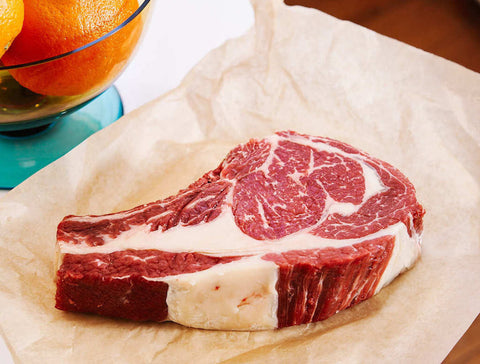This is not a typo! - today we're cooking beef shank.
I put my thinking cap on this week, I wanted to cook something that was unusual, economical and hearty.
Beef shank or whole beef shin is not a cut sold by most butchers. In fact I don't think I've ever seen it in a window. Usually the shank is either deboned for Gravy beef or cut cross-wise with the bone in for osso bucco. Either way I'm talking about a forequarter leg bone, the steer's humerus. This is a strong, weight baring bone that is thick and surrounded by hard-working tough muscle. It's packed full of flavour, but as we know with flavour it usually runs inversely to cooking time. The beef shank/gravy beef / osso bucco is the slowest cooking cut on a steer.
I discussed my needs with Davey Snags at Prahran and asked him if we had any beef osso that he hadn't cut yet. It turns out he did, luckily!
The beef shin has a joint at the top (thick end) and a joint at the bottom. When the steer is broken down half the top joint is still left on the piece, so this is the first thing Dave removed for me. Then at the bottom there's another thicker part of the bone that can be lopped off to save some room in your pan - you're still going to need a big one!
Here's what I was left with

I removed any obvious pieces of fat, connective tissue and sinew with a sharp knife.
One of the biggest assets of this cut is the thick marrow bone running left to right in the picture above. This bone is packed full of marrow which will drop out as it cooks and give a beautiful richness to your sauce or gravy. The marrow is soft even uncooked, see my thumb print here.

From here you've got a lot of choices for cooking and flavour, you could roast, braise, smoke, stew this joint. Many recipes will call for french style braising with stock or red wine.
I'm going to braise with 5 spice, miso paste, soy, chilli and ginger. Here's what you'll need:
- Oil
- Ginger
- Garlic
- Red chilli
- White onion
- Honey
- Soy sauce
- Miso paste
- Water
Preheat your oven to 180C
First I'll brown the shank on a super hot cast-iron pan. You'll need a powerful burner and heavy pan to get such a large joint brown as the cool temp of the meat will suck the heat out of the pan quickly.

It took a couple of minutes each side to seal it up nice and brown. You'll need a big dish suitable for the oven and with a lid to braise the shank. Here I'm using my tagine, but an oval cast iron dish should do the trick. My shank was ~25cm long.

Next for the braising stock chop the onions, galic and ginger and combine with a heaped spoon of miso paste. Saute' these in some oil. Then add ~4 tblsp soy sauce, ~2 tblsp rice wine vinegar, and 2 tablespoons of honey.
Rub a tablespoon of Chinese 5 spice into the meat and pour over the braising stock. Add hot water until the shank is sitting in 5cm of braising liquid.

Now for the easy part. Give it 20 mins at 180C, then turn it down to 150C and leave for 5-6 hours. You can check it occasionally and spoon the braising liquid over the top of the shank as you do.

After cooking you'll find the shank shrinks down the bone a lot. The bone can easily be lifted away leaving you to break up the meat.
The beauty of this cut becomes apparent after cooking, al the tough intercostal fabric breaks down and leaves soft and succulent textured meat. At this stage pulling with two forks is what I've done. You're looking at just over a kilo of cooked meat, so good for 5 people or a couple with leftovers!







